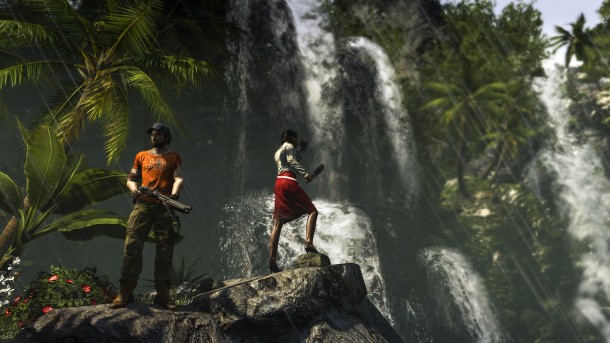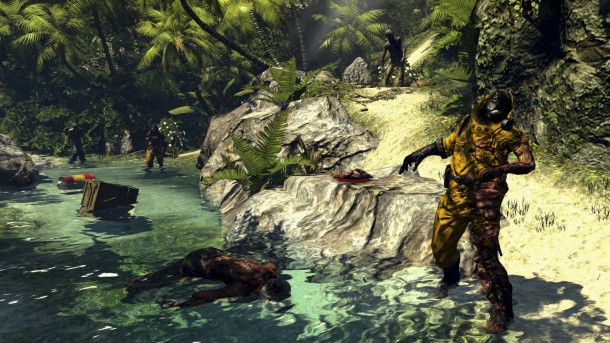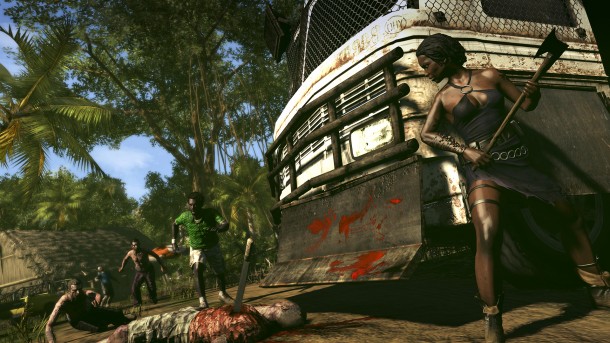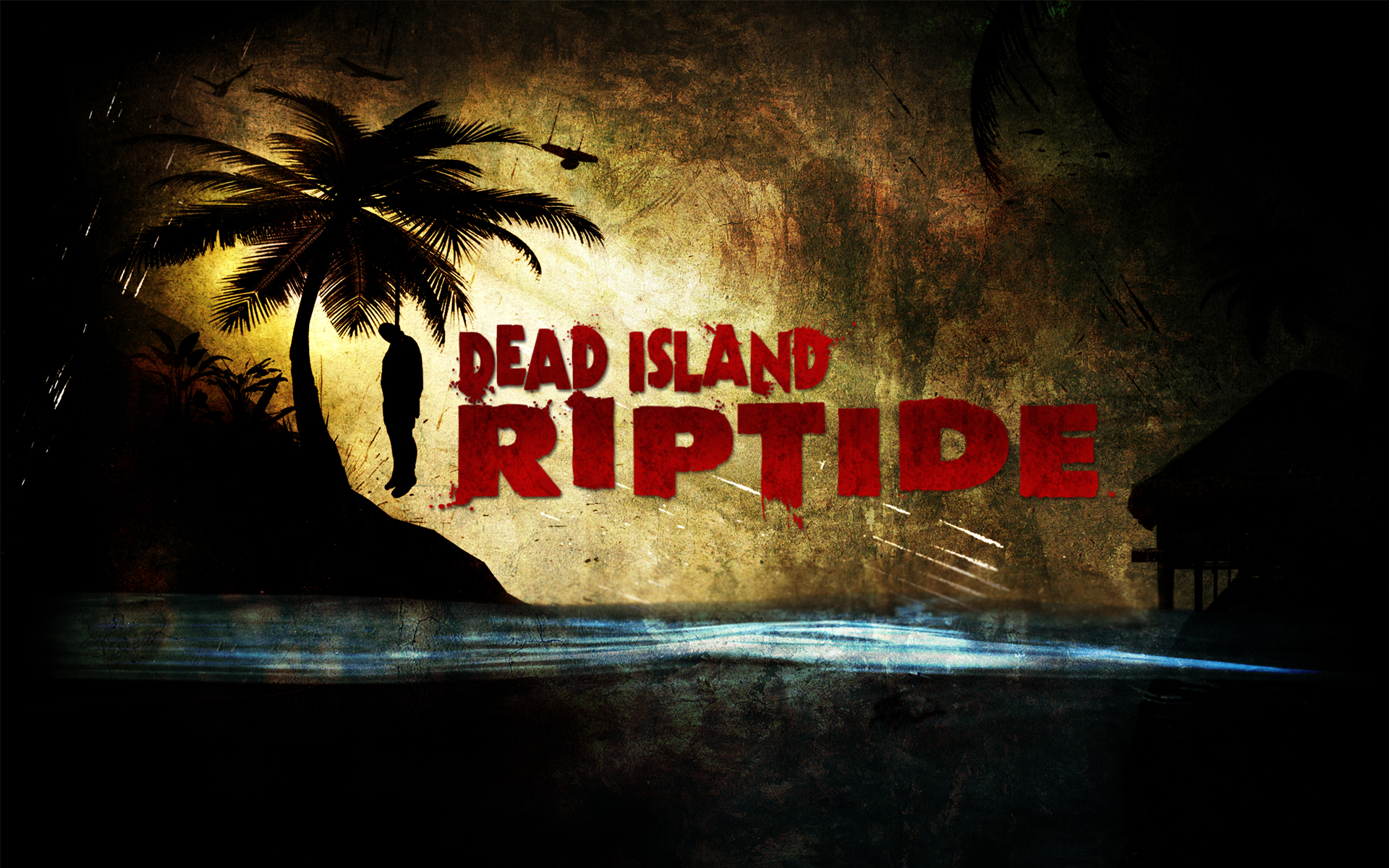Zombies have been popular for some time now. TV, movies, books and video games each have their own variations of the monsters, attempting to stand out among the hoard. Although Dead Island Riptide doesn’t attempt to reinvent the monsters, it does take a interesting, first person melee approach to dispatching the menace. Does this unique combat make Riptide stand out among the hoard, or does it shuffle its way to the back of the line?
After choosing from five different characters, each with their own weapon type specialization, or importing a Dead Island save, players are briefed on the events of Dead Island and then awoken on a military ship overrun with zombies. During the time spent on the boat, players are given their first taste of what the developers hope to convey throughout the game. The boat sets up a tense atmosphere, making players move slowly through its corridors. The first whack at combat conveys the idea of weight behind the melee weapons and allows you to see how guns fit into its ecosystem. The game’s story even sets up the group nicely, showing off the dynamics between all of these people that are now forced to work together. The ship, however, finds itself without a captain. And after slamming into a few rocks, the cast is thrown overboard. Once your survivor has washed up on the beach, the cruise has ended, and the realities of an open world start to set in.

The atmosphere quickly changes as you are dramatically shifted from a creaking desperate vessel to a lavish tropical paradise. All of the serious story development the game hints at quickly diminishes. It is hard to take a recorded message to a victim’s loved ones serious when it its being bookended by your character screaming “fuck yeah” after a successful group of kills.
Combat can become discouraging depending on your enhancements to weapons or the zombies at hand. With unmodified weapons, frequent engagements with two or three zombies can offer a good amount of challenge. However when three, four or possibly more zombies join the fight just out of player view, the engaging challenge turns to frustrating redundancy. These fights make up the majority of combat situations while moving between quests and it only takes a few cheap deaths before avoidance of combat altogether seems like a better idea.

Combat frustration does get elevated by upgrading and modifying weapons. These modifications range from things like barbed wire, meant to bleed the zombies dry, to elemental additions from something like a gas soaked cloth, helpful for igniting an entire room of zombies. In the early goings, players won’t have access to the resources or blueprints necessary to make these modifications and it is only through world exploration, sidequests and team fetch quests that mods and parts can be found. Guns are added back into gameplay around the halfway point and never feel overpowered or an obvious choice in situations over the melee weapons. Once you have this power added to a good amount of your inventory, it turns a large amount of the trying combat into lifeless battles, making it possible to slice through hordes with just a few swings.
Survivors can also specialize in fury, a charged special ability that gives an extra advantage in combat. Often its used as an escape if the mob is over running you, but doesn’t guarantee you won’t still die from its damage. These can be used to clear flocks of zombies if focussed while leveling.
Strategic leveling can turn most niches of combat into reliable strategies. If you have a particularly favorite weapon type or damage approach specializing down the correct trees will allow for a greater deal of damage to be pushed out.
This doesn’t mean the modifications drain all the fun from combat, as the specialty infected zombies take care of that. These encounters never quite seem fair, and almost always boil down to how the enemy AI is reacting to the environment. Sometimes enemies will constantly be on the attack, not allowing you to effectively get any hits. But then at other times, enemies will get stuck or complacent around an object, allowing players to just mash at it until it dies. These larger enemies are often able to dispose of you in one hit and if any additional zombies are there crowding the environment it might be a few lives before you even get a chance to attack the specialty infected.
Multiplayer can lower the death count against these infected, but that’s about all it offers. Players are able to jump into anyone else’s public game who has an equal or lesser number of story missions complete. Survivors joining another session are able to take their level and inventory with them, but won’t be able to progress any of their current story missions or side quests. Players are able to trade between co-op partners and can heal one another in the middle of a battle but are often off flailing at their own hoard of zombies, preventing them from helping the team. All characters have team buffs they can spec into, but that doesn’t mean they will or that you will see noticeable benefits. Playing through with a friend does breaks the monotony of the world even though their addition does not alter gameplay.
Navigation brings another frustration to open world gameplay. Active quests are marked on a radar on the hud and a on a map in the pause menu. However, neither of these do a good job of identifying just how to go about reaching a location. The radar has no representation of the map rendering it almost useless save for its ability to point out the nearest workbench or if you are around quest activities. Inexplicably, it will at times show you the direct route to a quest, but this is mostly reserved for main story missions. Different paths and routes are also sometimes only accessible coming from certain directions, something the in game map does nothing to point out. These problems make it easy to get turned around and, depending on how much area you have to backtrack, zombies could’ve already repopulated the area.

The game is fairly long. First playthroughs can clock in anywhere from 15-20 hours depending on how worth while you find sidequests and their potential to lead to mods and resources . If you’re starting a new character at level 15, expect to spend upwards of 30 hours in game to reach the games max level of 70.
Like the weapons in the game, Dead Island Riptide starts to break down after awhile. Repetitious encounters and horrible navigation mar what could be an interesting open world and combat system, forgettable story elements move along a plot for no reason other than to make players find new areas and four player co-op is useful only to allow players to not have to suffer alone. With the constant onslaught of games coming out, Dead Island Riptide might get devoured in the mob.
This review is based on an Xbox 360 retail version of the game provided by publisher Deep Silver



2 Comments